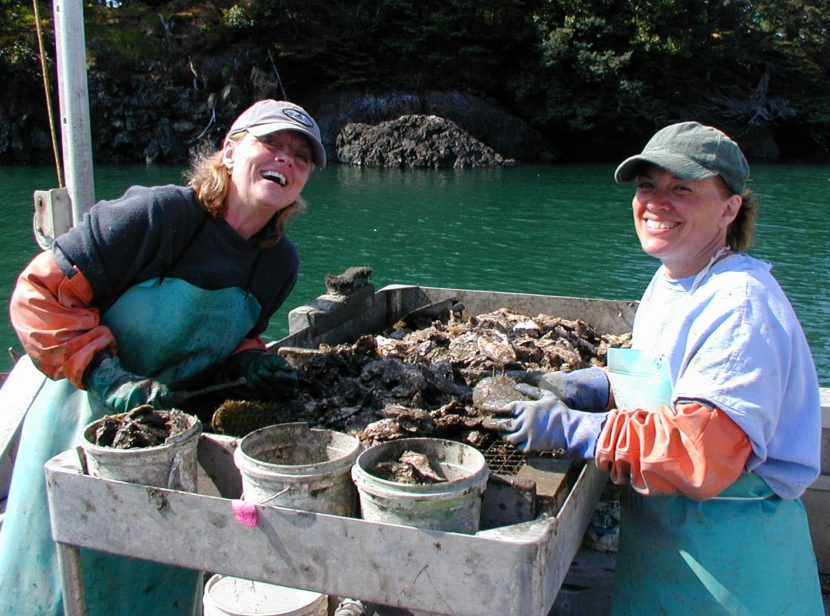
Alaska shellfish farmers hope a new state mariculture initiative will help boost their businesses. But they warn it’s not an easy industry to expand.
The state began allowing Alaskans to farm shellfish almost 30 years ago.
The resulting farms raise scallops, mussels and several species of clams. In recent years, oysters have gotten more attention.
The state lists about 50 shellfish farmers though not all are active. Most are in southern Southeast Alaska or Kachemak Bay, near Homer.
“I think the market in Alaska has not been fully saturated. So I think there’s plenty of room here,” said Margo Reveil, president of the Jakolof Bay Oyster Co. as well as the Alaska Shellfish Growers Association.
She said a lot of sales are within the state. But growers are looking farther away.
“I think that some farmers are similar to salmon fishermen, finding that direct sales and online sales can bring a premium that makes your farm viable,” she said.
The Walker-Mallott administration sees growth potential too.

The governor signed an administrative order in February setting up the Alaska Mariculture Task Force. It’s charged with making recommendations for a long-term plan to advance the state’s mariculture – or ocean farming – industry. It, by the way, does not include fish.
Barbara Blake, special assistant to the lieutenant governor, said the task force will play an important role in industry growth. She notes other shellfish-farming states have that in common.
“No state has been successful without first coming to the governor’s office and having the governor lead an initiative that would bring all those resources together, pull all of those who are interested or who are already developing in that world to one table to help develop a framework that would be statewide, individual or even region-wide,” she said.
The idea came from Julie Decker, executive director of the Alaska Fisheries Development Foundation.
She said the panel will learn from experienced farmers and outside industry experts.
“And we think that we can apply mariculture in Alaska in a way that Alaskans want it to be applied and do something that’s really positive that’s good for our communities, the environment and the economy as well,” she said.
Not that there aren’t significant barriers to the business.
Oyster farmer Reveil starts with Alaska’s water temperature.
“It takes three to seven years depending on your location and what size oyster to grow to size, so there’s a long lag time between changes and what farmers see out in the water and actually in their businesses,” she said.
Another barrier is the availability of brood stock. Competition and environmental conditions have led to shortages of shellfish larvae.
Oyster seed can be purchased from out of state. Decker said that’s not the case for other farmed species.
“If you want to grow geoducks, if you want to grow king crab, if you want to grow rock scallops (or) sea cucumbers, production of that seed must occur inside the state,” she said.
In-state supplies have improved, but more may be needed to support industry growth.
Then there’s the problem of finding people in the right situation and with resources to do the job.

The Sealaska regional Native corporation’s Haa Aaní division has a mariculture program that helped start oyster farms in several Southeast locations.
But the division’s Shawn Blumenshine said it’s difficult to find people who can keep them going.
“The farmers we’ve been working with over the past number of years have, for different reasons, decided to quit farming more or less,” she said.
Haa Aaní provided loans and expertise. But Blumenshine said the farmers had a hard time making ends meet while they waited for their crop.
“There’s a lot of cash investment up front and it takes a while before it starts paying off. And it makes it tougher for the farmers who have families and responsibilities to … survive in that interim while they’re cultivating the oyster and getting it ready for market,” she said.
Decker said there’s a new crop that could help build the industry. It’s seaweed and kelp, which are in demand for food and beauty products.
“It’s a very short turnover, six to nine months. So you have more of a cash flow involved for farmers, instead of waiting three, four to 10 years or so for a crop, depending on the species,” she said.
Farmer Reveil said it’s worth trying.
“We, actually, on our farm are experimenting with it right now. I think there’s some potential there. There’s a lot to be worked out on the processing side and the shipping side,” she said.
The new Mariculture Task Force will involve shellfish farmers, industry associations, the university and state officials. The cost of its work will come out of existing agency budgets, so it will require no new appropriations.
Officials are in the process of choosing its 11 members. Their recommendations are due within about two years.
